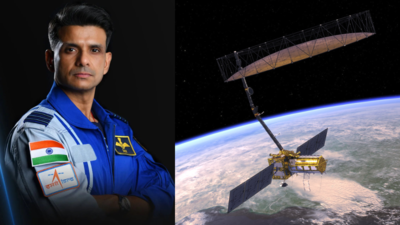NEW DELHI: Isro is gearing up for two high-profile space missions over the next two months — astronaut-designate Shubhanshu Shukla is set to travel to the international space station (ISS) in May as part of the Nasa-collaborated Axiom-4 mission, followed by the launch of the world’s most expensive Indo-US Earth observation satellite, NISAR, in June from Indian soil.
IAF Group Captain Shukla, who was imparted training in Russia and US for a space trip, will be the second Indian to visit space after Rakesh Sharma, who went to space on Russia’s Soyuz spacecraft four decades ago.
Making the announcement on Friday, space minister Jitendra Singh said, “Group Captain Shukla’s journey is more than just a flight — it’s a signal that India is stepping boldly into a new era of space exploration.”
Isro is also set to launch the Isro-Nasa jointly produced NISAR satellite in June onboard the GSLV-Mark 2 rocket, Singh said and added that in July the space agency will put in orbit BlueBird Block-2 satellites of US-based AST SpaceMobile using the heavy-lift LVM-3 rocket.
According to Nasa, the $1.5billion Nisar project “will measure the Earth’s changing ecosystems, dynamic surfaces and ice sheet collapses, providing information about biomass, sea level rise, groundwater and natural hazards, including earthquakes, tsunamis, volcanoes and landslides”.
Nisar will be the first satellite of its kind in space to systematically map Earth, using two different radar frequencies (L-band and S-band) to measure changes in the Earth’s surface less than a centimeter across. Under the terms of the 2014 agreement, Nasa is providing the mission’s L-band SAR, a high-rate telecommunication subsystem for scientific data GPS receivers, a solid-state recorder and a payload data subsystem. Isro, on the other hand, is providing the satellite bus, an S-band SAR, launch vehicle (GSLV Mk II), and associated launch services.
During the occasion, Isro chairman V Narayanan made a presentation on various upcoming space missions.
Isro also plans to launch the PSLV-C61 mission carrying the EOS-09 satellite, which is equipped with a C-band synthetic aperture radar, capable of capturing high-resolution images of Earth’s surface under all weather conditions, day or night. Another significant milestone will be the Test Vehicle-D2 (TV-D2) mission, designed to simulate an abort scenario and demonstrate the Gaganyaan Crew Escape System.
The mission includes sea recovery operations for the ‘crew module’, mimicking procedures planned for India’s first human spaceflight, he said.
Shukla’s journey aboard the Axiom-4 mission to the ISS is expected to provide critical hands-on experience in spaceflight operations, launch protocols, microgravity adaptation, and emergency preparedness — all essential for India’s crewed space ambitions, an official statement said. His ISS trip will also help in the country’s first human spaceflight mission Gaganyaan.
Isro to launch 2 high-profile space missions: Indian astronaut going to ISS in May, NISAR sat liftoff in June
Science
April 19, 2025
